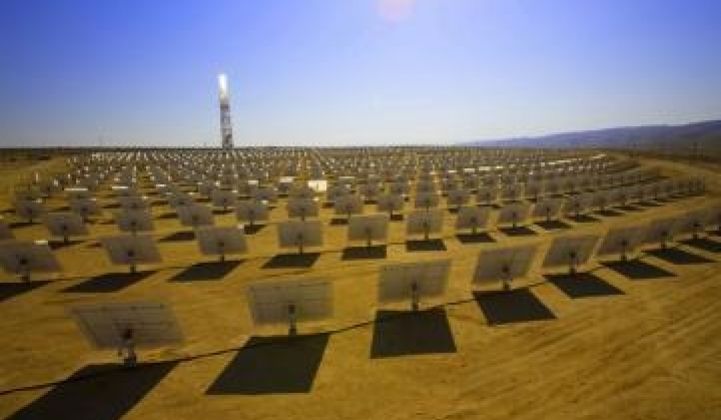BrightSource Energy’s planned Ivanpah plant will be one of the world’s largest solar farms -- and possibly its most efficient.
When the solar-thermal plant is built on the edge of the Mojave National Preserve (construction is expected to start this year), it will operate at 18 percent efficiency and earn a capacity factor of 30 percent.
This performance should make the 392-MW facility more efficient than plants with crystalline-silicon panels, thin-film cells or rival thermal technologies using parabolic mirrors, according to analysts.
The plant is to be laid out on three nearby tracts covering 3,500 acres of desert and should run at full capacity 10 to 11 hours a day. The company says a back-up natural gas system will aid performance during its long hours of operation, easing power fluctuations on cloudy days.
This consistency of power should put electricity costs on par with natural-gas plants, something photovoltaic plants will take another two years to achieve, some analysts say. While comparing plants is complex and imperfect, the newly available figures from BrightSource make the exercise a useful chore. Sun intensity, atmospheric moisture levels and power transmission costs of course differ plant location to plant location.
But determining who holds the industry’s bragging rights -- as well as who deserves project investment dollars -- is a task utilities attempt everyday, despite the difficulties. In an interview, BrightSource Product Manager Andy Taylor described Ivanpah’s efficiency as a sunlight-to-electricity calculation based on two years of testing the company’s Luz Power Tower 550 in Israel’s Negev Desert.
At the top of the towers, boilers absorb sunlight reflected from 7-square-meter ground-mounted mirrors and heat water to more than 1,000 degrees Fahrenheit, the highest temperature in the industry. The super-heated steam drives turbines.
The company says a back-up natural gas system permits the long operating hours and the ability to run most of the day at full capacity. The gas is used to warm boilers in the morning and augment solar power on cloudy days to keep output high. “We’re pretty much a sun-up-to-sun-down resource,” Taylor says.
BrightSource, which has so far raised more than $300 million in financing, expects the plant’s efficiency to rise as the company moves beyond its first-generation technology. Higher-efficiency turbines are already in the market, and additional mirrors, or heliostats, can be deployed. Water temperatures also will rise to above 1,100 degrees.
In contrast to Ivanpah’s 18 percent efficiency, the efficiency of utility-scale crystalline silicon and thin-film plants is likely less than 12 percent. Solar-thermal plants with parabolic mirrors also have difficulties keeping up. Ivanpah’s higher boiler temperatures give it an advantage, and dual-axis tracking can more accurately follow the sun through the seasons. The average efficiency of other solar thermal plants is 13 to 15 percent, says Cara Libby, project manager at the Electric Power Research Institute.
That doesn’t mean Ivanpah won’t have competition. One crystalline-silicon vendor, SunPower, with industry-leading 18-percent-efficient solar cells, could give BrightSource a run for its money, says Travis Bradford, president of the public-policy think tank, Prometheus Institute. A SunPower farm with a single-axis tracking system could have an efficiency of 15 percent, or maybe slightly higher depending on the location, he says.
Broader competition will come with falling solar-panels prices, unless a stronger Chinese currency slows the trend. Panel prices tumbled about 40 percent last year and, while they are more stable this year, they continue to decline more rapidly than solar thermal efficiency is improving.
BrightSource responds that plant efficiency is only one measure of performance, and not necessarily the best. Capacity factor, a calculation of a farm’s ability to deliver full power over time, may be more important, the company says. Ivanpah’s capacity factor (including the use of natural gas) should be 30 percent, Taylor claims. A wind farm in an ideal location (think Tehachapi) can have a factor of 40 percent. Photovoltaic plants generally are lower. A Carnegie Mellon Electricity Industry Center study estimates a PV plant in Arizona should be closer to 20 percent.
Another useful metric is the delivered cost of electricity. BrightSource claims this measure makes Ivanpah “extremely competitive,” but declines to release figures to back up the claim. The calculation looks at plant output versus costs and factors in development and financing charges. An examination of California Public Utilities Commission documents shows only that expected delivered costs are to be less than 12.5 cents a kWh. It doesn’t state how much less.
Nevertheless, Nathaniel Bullard, a solar analyst at Bloomberg New Energy Finance, calculates that the cost of Ivanpah’s electricity will be lower than photovoltaic power and about the same as natural gas. Of course no one knows for sure until the plant is built. “We’ll see if they can meet the targets they have in place,” Bullard says.



